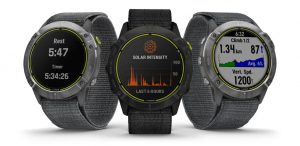
Hiking watches a special position in the line of sports watches. Modern models are designed in such a way that the accessory can withstand heavy loads, low temperatures, and be shock and drop resistant. That is, they should not fail after heavy rain or accidentally hitting a stone, or being discharged at the wrong time. The watch must be “tenacious” in every sense of the word: shockproof, waterproof and does not require charging twice a day.
Before, watches were taken on a hike only to watch the time and get up on an alarm clock. Now they can replace several devices at once: help navigate, predict the weather, show the time of sunrise – that is, be a real on-board computer for a tourist. We figure out what functions are in modern watches and choose which of these will be useful in tourism. Even though smart watches have many functions, they are not as good as hiking watches. But when choosing a hiking watch, you also need to pay attention to some things, so that they do not let you down in the most difficult moments. We will highlight a few points of the most important thing while choosing hiking watches. Let’s get started.
-
Impact resistance
Shockproof models are designed to protect fragile parts of the movement and dial from any kind of damage. With an active lifestyle, sports and travel, extreme situations are inevitable, and the watch case must withstand the force of shock and vibrations. It has a reinforced structure the performance is different for quartz and mechanical watches.
A protective panel that covers the dial is responsible for this. It can be made of polymer, mineral or sapphire glass. Polymer (or organic glass) is found in the most budget models. It is quite durable, but scratches quickly appear on it and the glass becomes cloudy. Mineral glass is used in most modern watches – it is much more difficult to scratch, and almost impossible to break, and scratches are easy to grind in a workshop. The sapphire crystal does not break or scratch at all. This is the most expensive coating material, but it is justified by its durability.
-
Water resistance
Drops of water on contact with the mechanism can quickly disable it. Your best bet is a watch that is water-resistant to at least 10 bar at a depth of 100 meters. Such models will withstand rain, wash in the shower, are suitable for swimming and diving to 3-5 meters.
There is a subtlety here: the number in meters does not mean the working depth to which you can dive with the watch. This is the depth at which the watch can withstand the equivalent water pressure in laboratory tests. In practice, however, watches with a water resistance of 30 m / 3 atm, manufacturers recommend the maximum for walking in the rain. That is, they are suitable for hiking and mountain trips, but for water tourism it is better to choose a watch with a WR of 50 m / 5 atm. Water resistance 100 m and above is already suitable for scuba diving.
-
Power charging
In conditions far from civilization, it is rarely possible to set aside time for manual winding or battery replacement. All hiking and travel watches are multifunctional, and the accessories and lighting are the most energy consuming. We recommend choosing a solar-powered watch – it is charged from any light source, a couple of minutes in the sun is enough for the accessory to work for more than a day.
A watch with a rechargeable battery lasts much less. Depending on the model and the modes used, the operating time on a single charge can be from 10 hours to 1 month. The fastest drain on the battery is the use of GPS: the more often you access the satellites, the sooner the battery will drain. That is, if you continuously write a detailed track, the clock can be discharged in 10 hours. Therefore, if you go on an autonomous hike, where there will be no houses with outlets, and at the same time want to use a watch with GPS, get ready to take a charger or solar battery with you.
-
Useful functions
A hiking watch can make life easier and reduce the weight of a backpack by collecting many devices in one case. World modern brands generously endowed accessories with all kinds of complications. We choose which of the sports watch functionality will be useful on a hike.

1. Compass
It is found in almost all sports watches, but it comes with tilt compensation (it can be called a “3D compass”) or not. A watch with a compass without tilt compensation must be held strictly horizontally, and the 3D compass shows the correct value regardless of the position on the hand.
2. Barometer
It measures atmospheric pressure, builds a graph of its changes and thus helps to predict the weather for the next day. The principle is simple: if the pressure drops, rain is likely, if it rises, the weather improves, if the schedule is even, the weather will not change.
3.A storm warning
In case of a sharp drop in pressure, the watch beeps about the possible approach of a storm. This is an important feature for autonomous travel – when there is no connection around, such a signal will tell you to find shelter and wait out the bad weather.
4. Thermometer
The range of measured temperatures may differ for different watch models. For example, Garmin, which is one of the best hiking watches, has an operating temperature of -20 ° C to + 60 ° C. This should be taken into account if you are going on a winter hike or in the highlands. Another important point: in order for the thermometer readings to be accurate, the watch must be removed from the hand and wait a while.
5. Navigation
People who love hiking, trail running and the great outdoors need a reliable GPS watch, which can offer top navigation features and a long battery life set up for multi-day adventures.
Do you need a navigator in your watch for tourism? The question is not at all simple. On the one hand, the ability to record a track and view it with one movement of your hand looks very attractive – you don’t need to take a lot of gadgets on a hike, the navigator is always in your hand. On the other hand, the work of GPS in the watch quickly drains the battery, which means that you have to take a charger with you and there will be no gain in weight. And in a serious autonomous hike, a tourist GPS navigator with a large screen and detailed maps will be an order of magnitude more reliable and convenient to use. There must be at least one such navigator per group – or at least a map with a compass.
However, the watch’s GPS function can be a nice and handy addition. Garmin has a huge database of topographic maps and ready-made routes that can be downloaded in advance and used as a safety net on your route.Ski tourists use the GPS in their watches to memorize the heights on the lifts and then not go lower than necessary.
This information will help you to choose the right hiking watch for a long use. Remember, the general smartwatches will not replace a hiking watch on hike.




